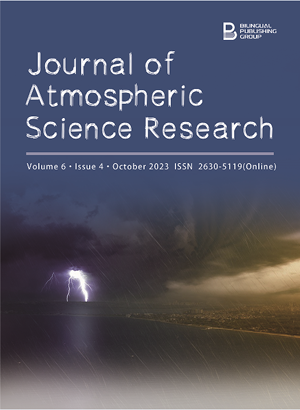-
861
-
411
-
362
-
359
-
350
Problems and opportunities for biometeorological assessment of conditions cold season
DOI:
https://doi.org/10.30564/jasr.v6i4.5935Abstract
The article is devoted to a discussion of the possibilities of biometeorological assessment of the severity of weather conditions during the cold season. The relevance of the study is ensured not only by the fact that residents of a number of states, whose total number is more than 27 million people, live in these extreme climatic conditions, but also by the need to improve biometeorological approaches to assessing the impact of these conditions on the body and health of the population. This study examined biometeorological characteristics that illustrate a measure of cold stress. These include the Siple wind-chill index; Bodman winter severity index; Arnoldi weather hardness coefficient; Mountain wind chill index; weather hardness coefficient according to I.M. Osokin. The results of a comparison of winter severity assessments based on the values of the calculated Siple and Bodman indices made it possible to establish that the Bodman index is more acceptable when assessing mildly severe winters. The most adequate for assessing the “severity”of the cold period against the background of a decrease in air temperature and an increase in wind speed is the Siple index. The need to provide the countries of the world with high-quality hydrometeorological and biometeorological forecast information is justified and relevant. In this regard, these studies are very promising.
Keywords:
Biometeorological indices; Severe weather; Cold period of the year; “rigidity” of weather conditions; Cold stress; Biometeorological assessmentReferences
[1] Андреев, С.С., Андреева, Е.С., 2004. Краткая биоклиматическая характеристика Ростов-ской области (Russian) [Brief bioclimatic characteristics of the Rostov region]. Метеорология и гидрология. 8, 53-60.
[2] Головина, Е.Г., Рус анов, В.И., 1993. Некоторые вопросы биометеорологии (Russian) [Some issues of biometeorology]. Spb.: Izd. RSHU. TSU. p. 90.
[3] Extraordinary Meeting of the SERCOM/SCDRR Advisory Group on Severe Weather Forecasting (AG-SWF) [Internet]. World Meteorological Organization; 2023 [cited 2023 Sept 25].
[4] Tromp, S.W. (editor), 1960. Biometeorology. Proceedings of the Second International Biocli-matological Congress; 1960 Sep 4-10; London. Paris: International Society of Biometeorology.
[5] Русанов, В.И., 2004. Биоклимат Западно-Си-бирской равнины (Russian) [Bioclimate of the West Siberian Plain]. Tomsk. Izd. IOA SO RAN. p. 208.
[6] Essex, C., McКitrick, R., 2004. Taken by storm: The troubled science, policy and politics of global warming. Canadian Public Policy. 30(3).
[7] Дмитриев, В.В., Примак, Е.А., Скрыгина, В.К., 2011. Интегральная оценка устойчи-вости и экологического благополучия гео-систем (Russian) [Integral assessment of the sustainability and environmental well-being of geosystems]. Международный журнал экс-периментального образования. 5, 137-138.
[8] Резник, Л.Г., Шелякин, А.С., 2001. Инте-гральные показатели суровости совокупноговоздействия климатических факторов (Russian) [Integral indicators of the severity of the cumulative impact of climatic factors]. Межву-зовский сборник научных трудов Тюменско-го индустриального университета. 203-209.
[9] Арнольди, И.А., 1962. Акклиматизация чело-века на Севере и Юге (Russian) [Human acclimatization in the North and South]. M. MedGiz. p. 71.
[10] Андреева, Е.С., 2006. Опасные явления пого-ды юга России (Russian) [Dangerous weather phenomena in southern Russia]. Spb. Izd. ВВМ. p. 216.
[11] Адаменко, В.Н., Кондратьев, К.Я., 1999. Ан-тропогенное воздействие на природу Севера (Russian) [Anthropogenic impact on the nature of the North]. Apatity. Izd. KNZ RAN. 17-34.
[12] Комплексные исследования природной среды Арктики и Антарктики (Russian) [Comprehensive studies of the natural environment of the Arctic and Antarctic]. Сборник тезисов и докладов: Izd. AANII. p. 408.
[13] Андонова, А.С., Бабин, А.В., Викулина, М.А., et al., 2013. Влияние изменений кли-мата и опасных природных явлений на природопользование Европейского Севера (Russian) [The impact of climate change and natural hazards on environmental management in the European North]. Spb. Izd. RSHU. p. 124.
[14] Andreev, S.S., Popova, E.S., 2012. Global warming and anthropogenic factor. European Journal of Natural History. 4, 27-28.
[15] Денисов, О.В., Губеладзе, О.А., Месхи, Б.Ч., et al., 2016. Комплексная безопасность насе-ления и территорий в чрезвычайных ситуаци-ях. Проблемы и решения (Russian) [Comprehensive security of the population and territories in emergency situations. Problems and solutions]. RnD. Izd DSTU. p. 278.
[16] Александров, А.А., Ларионов, В.И., Сущев, С.П., 2019. Анализ и управление техно-генными и природными рисками (Russian) [Analysis and management of man-made and natural risks]. Moskow. Izd MGSU. p. 360.
[17] Basilaia, M.A., Bogdanova, I.V., Dymnikova, O.V., 2019. Cosmoharmonic principles of environmental safety. Innovative Technologies in Environmental Science and Education. 135,01079.
[18] Плешко, М.С., Насонов, А.А., Дымникова, О.В., et al., 2020. Обеспечение комплексной безопасности работ по восстановлению иреконструкции шахтных стволов (Russian) [Ensuring comprehensive safety of work on the restoration and reconstruction of mine shafts]. Горный информационно-аналитический бюл-летень (научно-технический журнал). 7, 104-112.
[19] Belushkina, G.V., Bulygin, Yu.I., Deundyak, D.V., 2010. Calculation of the accumulation of harmful substances in a closed volume of a machine running-in room in an emergency situation. Advanced Engineering Research. 10(3), 397-401.
Downloads
How to Cite
Issue
Article Type
License
Copyright © 2023 Elena Sergeevna Andreeva, Sergey S. Andreev

This is an open access article under the Creative Commons Attribution-NonCommercial 4.0 International (CC BY-NC 4.0) License.




 Elena Sergeevna Andreeva
Elena Sergeevna Andreeva






